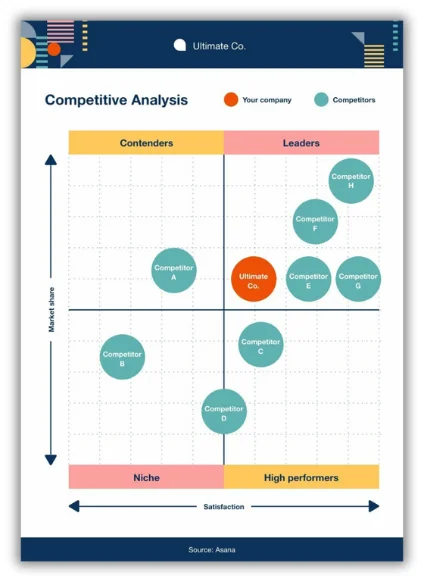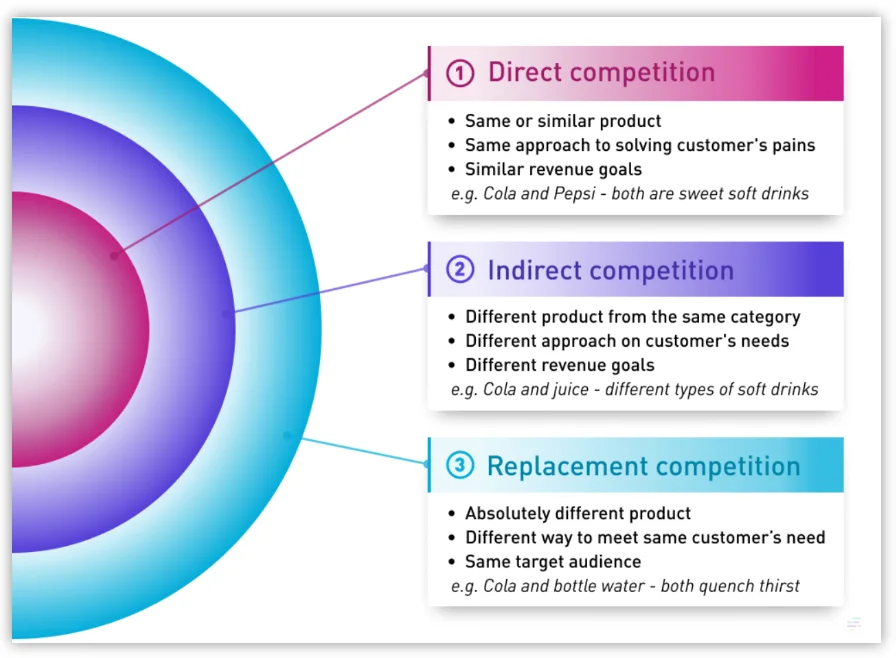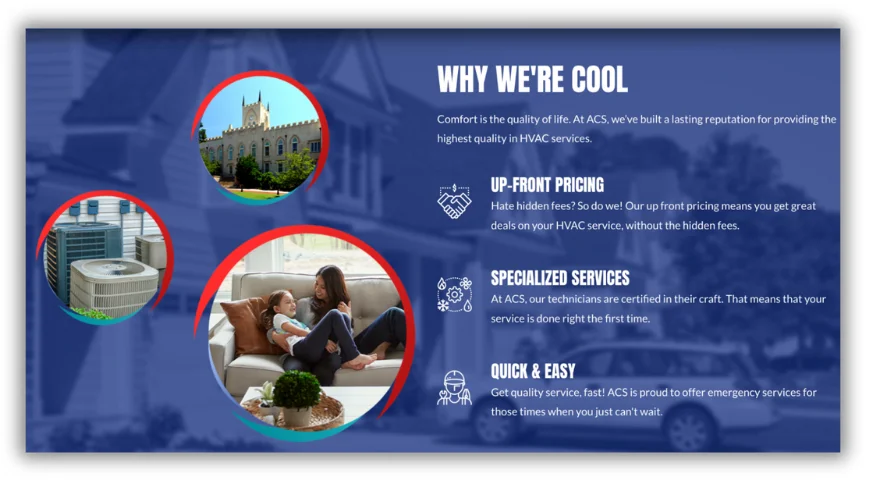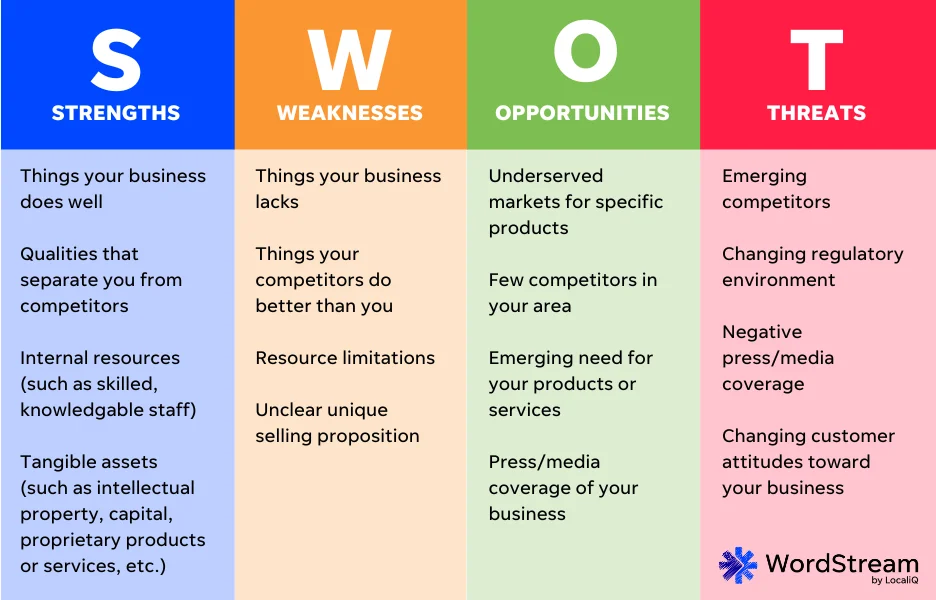I don’t know about you, but the term “competitive analysis” feels intimidating. “Competitive” feels like work and “analysis” feels like time.
The good news is, competitive analyses do not have to be hard! And that’s key, because you need to conduct these pretty regularly if you want to stay afloat in your market.
In this post, I’m going to share with you a fast and easy five-step competitive analysis process that you can apply to your business. But first, let’s make sure we’re clear on what a competitive analysis is and why it’s important.
Contents
- What is a competitive analysis?
- How to do a competitive analysis in 5 steps
- Final tips on doing a competitive analysis
What is a competitive analysis?
A competitive analysis is the process by which you compare your business to your competitors for the purpose of standing out from them. There is no one-size-fits-all competitive analysis: You can conduct one for your business as a whole, for specific products and offerings, for specific marketing channels, and more. And you can use a competitive analysis to improve your marketing, bring new products to market, enter new markets, and more.

A competitive analysis is the key to identifying where you stand in your market.
🛑 Speaking of competitors…want to know how your Google Ads stack up to the competition? Download our Google Ads Benchmarks to find out!
How to do a competitive analysis in 5 steps
The five steps below provide the perfect framework for any type of competitive analysis you want to perform. Once you understand the main steps, use our competitive analysis templates to put it into action!
1. Identify your competitors
First and foremost, you need to identify who you’re competing against. It’s important to remember that there are different types of competitors:
- Direct competitors: Offer the same product/service and meet the same need.
- Indirect competitors: Offer a different product/service but meet the same need.
- Perceived/replacement competitors: Offer a different product/service that doesn’t exactly meet the same need but is similar enough to serve as a replacement for your product/service. They are perceived by your audience to meet the same need.

How to identify your competitors:
- Search on Googlefor the products and services you offer and see what comes up, both in local and general results. Search also for your business name to see if there are any businesses bidding on your business name in Google Ads.
- Use a competitive analysis tool like SimilarWeb, Semrush, or Ahrefs. These platforms often have freemium versions or free trials that will suffice for this first step. These tools for finding competitor keywords can also be helpful here.
- Look at review sites relevant to your industry. For example, service businesses may look on Google Maps and Angi while SaaS providers may look on Trustpilot and G2.
- Ask your customers. Find out who else they considered when deciding on a provider.
Collect as many competitors as you can and categorize them into the above-mentioned groups.
2. Identify your competitors’ products
It’s not enough to just know that they offer something similar to what you offer. Spend time on their website and nail down exactly what they offer. Most businesses, yours included, may have several offerings—and solid offerings, too—but there always tends to be one core offering that is the bread and butter. Find this out as well as the secondary offerings. For retail with several products, get a sense of their best sellers.
How to identify your competitors’ products/services:
- Act like a consumer. Use their product, solutions, and pricing pages, ask questions on live chat; you could even call and ask questions.
- Read reviews. Identify any products or services that get mentioned more than others. Also pay attention to what doesn’t get mentioned.
- Understand packages and pricing tiers. See how your offerings compare with them at the same price points. For example, a competitor might offer the same things as you but through a much higher-priced package.
- Look at keywords they’re bidding on. Use our above-mentioned tools for finding competitor keywords.

A quick scan through your competitors’ PPC keywords can reveal a lot about their core offerings.
🔎 Need help finding competitor keywords? Try our Free Keyword Tool!
3. Identify your competitors’ target audience
Yes—by definition, your competitors have the same audience as you—but every audience has its nuances, so it’s important to dig deeper. You want to identify not just demographics but also the personas your competitors are targeting.
How to find your competitors’ target audience and personas:
- Look at testimonials and case studies on their website. This can give you an idea of who the end users are of the product/service. Pay attention to their occupation especially.
- Check review websites. This can help you better understand the underlying pain points and expectations of customers, and the small details they point out can uncover information about their lifestyle (B2C) or work style (B2B).
- Look at their social media profiles. See who their posts and social media ads are geared for. You can learn a lot about who they’re targeting based on the copy and imagery. Also, look at which followers engage with their posts.

A quick browse through Wild One’s Instagram profile and you can see that they are targeting young urban pet owners.
And if you’re running paid ads, these strategies on targeting competitor audiences can help you as well.
4. Identify their positioning and messaging
No matter how many businesses there are that offer the same thing, each business has its own positioning (the context in which they offer their product) and messaging (the unique value the product provides). Understanding these is essential for developing your own positioning and messaging.
How to identify your competitors’ positioning and messaging
- Look at their business descriptions. A good business description distills the business down into key messaging points. Check business listings, social profiles, and review sites for these.
- Look at their “soft skill” content. I’m defining this content as things like their core values and about us pages. If they have an explicit mission statement, even better.
- Read press releases. Press releases are prime pieces of content for revealing a company’s position and messaging. Check local media and online press release sites.
- Subscribe to their newsletter or blog. You don’t have to read every post or email in detail, but regularly glancing at this content over time and paying attention to what gets repeated will help you to identify key messaging.
This information, along with the other website copy you analyzed in the previous steps, should be enough for you to get a basic idea of their key features and benefits, as well as their unique selling proposition.

Some companies even have a “why us” page, like this one.
5. Summarize it all with a SWOT analysis
A SWOT analysis is a nice way to develop insights and visualize all of the information you gathered in the above steps. SWOT stands for:
- Strengths: What the business does well.
- Weaknesses: Where it needs to improve.
- Opportunities: Outside factors that could provide a competitive advantage.
- Threats: Outside factors that could create a disadvantage.
You can do a SWOT analysis on your own company as well as your competitors. For help with this, use our SWOT analysis guide and template, and review these SWOT examples for inspiration.

Final tips on doing a competitive analysis
The five steps above should have you covered in doing a competitive analysis for your business so you can stand out. Here are a few final tips and best practices to keep in mind:
- Don’t use a marketing competitive analysis to decide what types of products or services to offer. Instead, use it to understand the best way to position your offerings and identify your unique value in your market.
- Stay unique. It’s okay to adapt ideas from competitors, but don’t copy them directly. Learn from their strengths, fill gaps where their weaknesses are, and stick with your brand story and what makes you unique.
- Keep your customers first. While it’s necessary to pay attention to your competitors, don’t get so caught up in the game at the expense of your customers. Make sure that your business is primarily focused on meeting the needs of your customers. Plus, they can be your most valuable source of information!
Start your competitive analysis now
With the steps and tips in this post, you are now ready to do a competitive analysis for your business. Use it to refine your positioning, messaging, and unique value proposition, and you’ll see what a difference this makes in your brand consistency and marketing effectiveness! To recap, here’s how to do a competitive analysis in five steps:
- Identify your competitors
- Identify your competitors’ products
- Identify your competitors’ target audience
- Identify their positioning and messaging
- Summarize it all with a SWOT analysis







